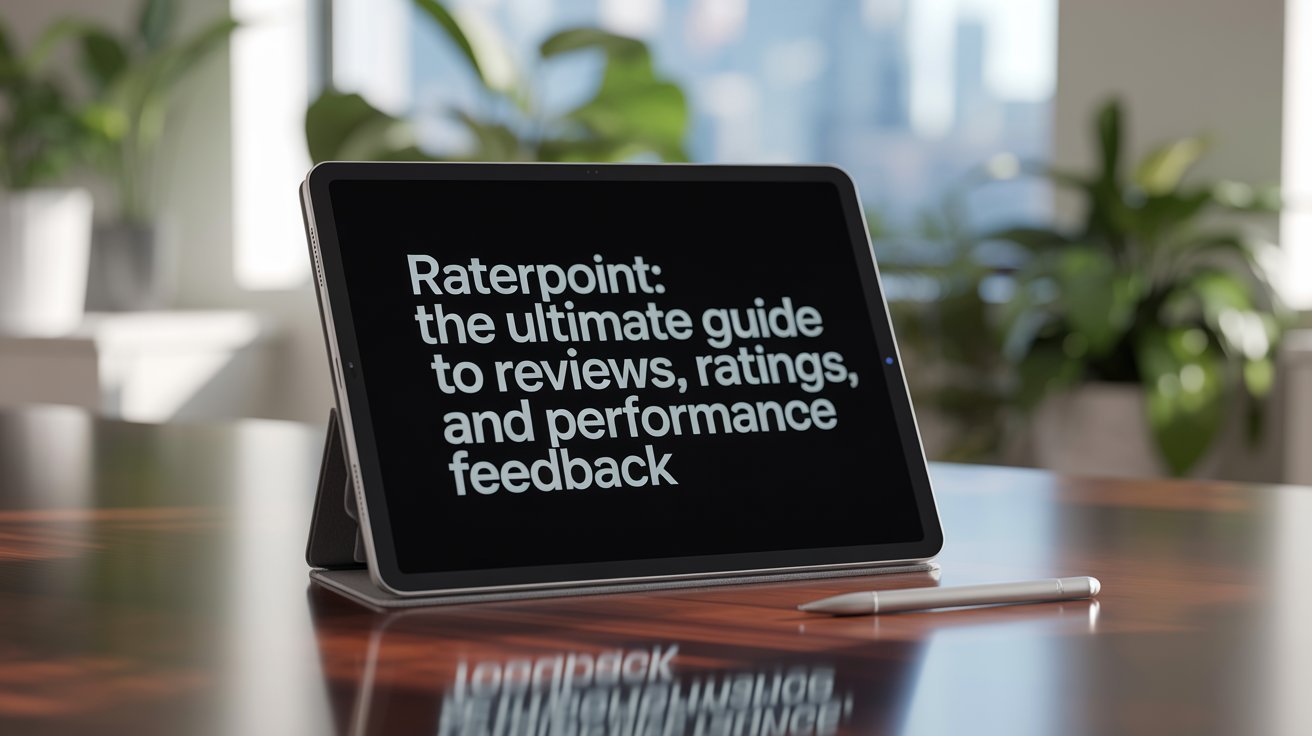What Is RaterPoint?
RaterPoint is an emerging platform designed to transform the way reviews, ratings, and performance feedback are collected and managed. Unlike traditional review websites, which often struggle with spam, fake reviews, and lack of accountability, RaterPoint puts trust and transparency at the center of its mission. It serves as both a consumer-facing review hub and an internal feedback tool for businesses, organizations, and teams. By combining verification mechanisms with modern analytics, RaterPoint allows users to gather insights that are accurate, reliable, and actionable.
For consumers, it provides a trusted space to read and share experiences about products and services. For businesses and organizations, it goes beyond star ratings to deliver dashboards, trend analysis, and even tools for employee or team evaluations. This dual-purpose structure makes RaterPoint more than just another review site—it’s an integrated feedback ecosystem.
How RaterPoint Works
At its core, RaterPoint gathers reviews from multiple sources, verifies their authenticity, and presents them through clear scoring systems and dashboards. The platform uses several layers of verification, such as proof-of-purchase checks, AI screening for suspicious activity, and even manual oversight to ensure integrity.
Unlike simple review platforms that display raw ratings, RaterPoint analyzes data to identify patterns, highlight sentiment trends, and give both consumers and businesses a deeper understanding of feedback. This blend of aggregation, verification, and analysis ensures that the information provided is trustworthy and valuable for decision-making.
Key Features of RaterPoint
- Verified Reviews – Each review undergoes a verification process to reduce spam and fake submissions.
- Centralized Monitoring – Businesses can consolidate reviews from various sources into one unified dashboard.
- Feedback Analytics – Charts, reports, and trend analysis tools provide detailed insights.
- Business Response Tools – Companies can directly respond to reviews, addressing issues and building trust.
- Performance Evaluation – Organizations can use RaterPoint to conduct structured team and employee reviews.
- Survey Support – Researchers and educators can design questionnaires and validate data quality.
Use Cases by Audience
For Consumers
RaterPoint empowers everyday buyers to compare products and services with confidence. Since all reviews are verified, readers can trust that the feedback reflects genuine experiences.
For Businesses & SMBs
Local businesses and small-to-medium enterprises can use RaterPoint to unify reviews across platforms, respond to feedback quickly, and track reputation trends.
For Enterprises & HR
Large organizations can leverage RaterPoint as an internal feedback system for employee evaluations, project reviews, and 360-degree feedback cycles.
For Researchers & Educators
Survey data collection and evaluation become more reliable with built-in quality checks, making RaterPoint useful for academic and institutional projects.
Getting Started with RaterPoint
Onboarding to RaterPoint is simple. Businesses create a profile, link external review sources, and customize their verification settings. They can then launch review request campaigns through email, SMS, or QR codes to encourage authentic participation.
Users monitoring internal teams or projects can set up evaluation cycles, define rubrics, and manage reviews from dashboards. Meanwhile, researchers can design survey questionnaires, configure sampling strategies, and monitor real-time results.
RaterPoint vs. Traditional Review Platforms
Traditional platforms often rely heavily on user submissions with little verification. This opens the door to fake reviews and bias. In contrast, RaterPoint focuses on trust and data integrity. Instead of simply displaying a static star rating, RaterPoint delivers trend analysis, detailed insights, and structured evaluation tools. This makes it suitable not only for consumers but also for businesses, teams, and researchers seeking a deeper view of performance.
Pros and Cons of RaterPoint
Pros:
- Verified and trustworthy feedback.
- Unified monitoring across multiple platforms.
- Advanced analytics and dashboards.
- Useful for both public and private evaluations.
Cons:
- As a growing platform, its ecosystem is still expanding.
- Feature availability may vary by region or business sector.
Practical Playbooks for Different Users
- Businesses: Use automated request flows, templates for responses, and escalation policies to maintain customer satisfaction.
- Teams & HR: Establish review cycles, set competencies, and ensure fairness with rater calibration.
- Researchers: Apply quality controls to data, design clear instruments, and validate responses.
These playbooks help users maximize the value of the platform based on their unique needs.
Measuring Impact with RaterPoint
Organizations using RaterPoint can track a range of key performance indicators (KPIs):
- Review velocity (how quickly feedback is being collected).
- Verification rate (percentage of validated reviews).
- Response time and resolution rate for issues.
- Changes in average ratings over time.
In addition, businesses can analyze sentiment trends, industry benchmarks, and cohort improvements to measure long-term impact.
Pricing and Plans
RaterPoint typically follows a freemium model:
- Free access for readers and individual reviewers.
- Basic tools for small businesses.
- Paid subscriptions for advanced features such as detailed analytics, multiple team accounts, or enterprise integrations.
Pricing depends on factors such as the number of seats, locations, integrations, and reporting requirements.
Integrations and Compatibility
RaterPoint can connect with popular review sources and social platforms, allowing businesses to unify feedback from across the web. For internal uses, it integrates with HR software, survey pipelines, and evaluation tools, ensuring smooth workflows.
Security, Compliance, and Trust
Security is central to RaterPoint’s mission. It uses identity validation, fraud detection, and governance controls to maintain data integrity. Organizations using it for performance evaluation or research can rely on compliance features to safeguard sensitive data.
Troubleshooting and Best Practices
- Low Response Rates: Adjust request timing, use multiple channels, and offer transparent incentives.
- Verification Issues: Provide clear instructions for proof-of-purchase or eligibility.
- Noisy Data: Train raters on rubrics and improve clarity in survey or evaluation design.
By following best practices, users can ensure they gather reliable and actionable feedback.
Alternatives and Complementary Tools
While RaterPoint is unique, some businesses may also use:
- Traditional review sites (Google Reviews, Yelp, Trustpilot).
- Reputation management platforms.
- Standalone survey and feedback tools.
RaterPoint stands out by combining all of these into one ecosystem.
Real-World Examples
- A local restaurant consolidates reviews from multiple sites and improves its average rating by responding quickly.
- A corporate HR team uses RaterPoint to manage structured performance reviews and measure competency development.
- A research group designs a survey with quality checks to ensure only valid responses are counted.
These examples show the wide applicability of the platform across industries.
Roadmap and Future Outlook
As an emerging player, RaterPoint is expanding rapidly. Industry blogs and press outlets note its growing adoption in both consumer and enterprise spaces. With continued development, it is expected to strengthen integrations, expand analytics features, and refine performance evaluation workflows.
FAQs
How does verification work?
Through proof-of-purchase, AI checks, and manual review.
Can it pull reviews from other sites?
Yes, with supported integrations.
Does it support HR performance reviews?
Yes, through evaluation cycles and rubrics.
Is it free for consumers?
Reading and writing reviews is free; businesses may pay for advanced features.
Glossary
- Verification: The process of ensuring reviews are legitimate.
- Rater Calibration: Adjusting evaluator standards for consistency.
- Review Velocity: Speed of collecting new feedback.
- Sentiment Index: Measurement of positive or negative tone in reviews.
Conclusion
RaterPoint is more than just a review site—it’s a trust-first feedback platform designed for both consumers and organizations. Whether you are a shopper seeking reliable insights, a small business looking to consolidate reviews, a corporate HR team conducting evaluations, or a researcher seeking high-quality data, RaterPoint offers a flexible, verified, and analytics-driven solution.
By bridging the gap between public reviews and structured feedback systems, RaterPoint is redefining how reviews and evaluations shape trust, reputation, and growth.
Do Read: Revo Technologies Murray Utah — Custom PCs, IT Services & Repairs






